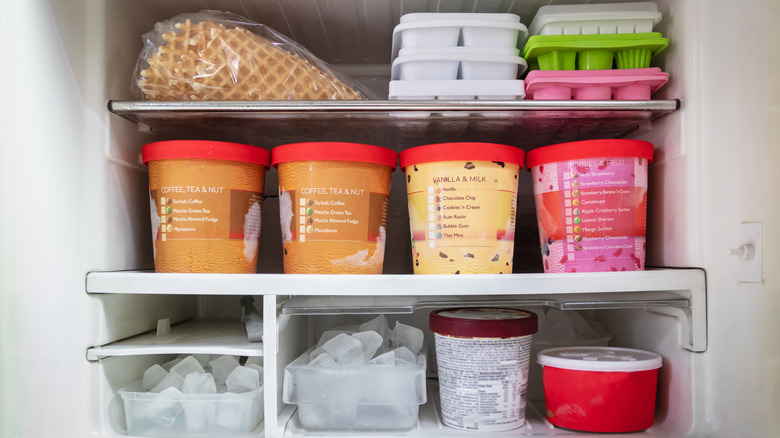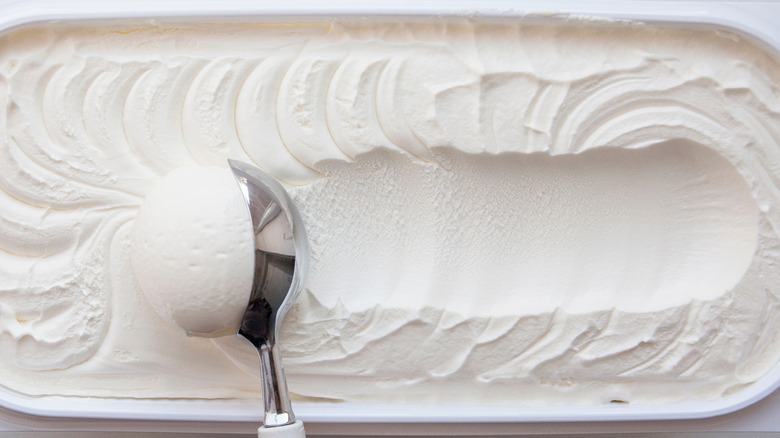Should You Be Throwing Out Freezer-Burned Ice Cream?
The silky, creamy consistency of ice cream is the foodstuff of dreams. So while the thought of something like oral surgery might be terrible, having a legitimate excuse to eat ice cream for every meal almost makes it worth it. Ok, that one is a bit of a stretch, but those cold, sweet bites of ice cream are famous for a reason and 74% of Americans enjoy the frozen treat all year (per YouGov).
All jokes aside, most of us can probably agree that ice cream is just effortlessly good. Whether it's a dollop of soft serve atop a waffle cone or a pint of Ben & Jerry's, it's all a treat to look forward to and when a carton of vanilla loses itself to the confines of your freezer, it feels like a godsend to find. It becomes more of a greek tragedy, however, when you open up the container and find those familiar crystallized shards over the smooth vanilla bean sheen. It's freezer-burned. Most of us would probably trash anything caulked in those icy clutches out of disgust at the comprised taste, but should you throw out freezer-burned ice cream? It seems that there could be a fix for everything, so you may be able to salvage it.
The changing face of ice cream
Ice cream serves as a great canvas for food experimentation. It's easy to transform a bowl of the dairy treat with a sweet ice cream pie recipe. You could even try it rolled, coated in dry ice, or just have a classic scoop on top of a cone. Changing how we eat ice cream is easy thanks to its one special quality according to Dr. Chika Nweke, a teacher in ice cream manufacturing at University College London (per BBC). "It's one of the few products that holds all three states at once. It's solid, liquid, and gas, all in one," she said.
So, where are all these states that coexist inside of ice cream? According to ACS, small air bubbles make up 30% to 50% of the food, along with fats derived from milk and ice crystals hiding within. But how exactly do you make ice cream? It's pretty simple: Recipes often call for a combination of milk, sugar, and cream, according to Dairy Australia. From there, you mix in modifying agents and flavorings. Then, as the mixture combines, the temperature is altered from around 180 degrees Fahrenheit to a lower temperature to pasteurize the milk while eliminating bacteria. It also yields small ice crystals, which contribute to the creamy consistency, ACS explains. Next, the mixture sits between two to 24 hours before being frozen. After that, it could be at risk of freezer burn.
Is freezer burn a death sentence?
Like many dishes that have been around for centuries — Alexander the Great topped snow with honey in 200 B.C. — a modern twist has been attempted with almost every aspect of ice cream (via International Dairy Foods Association). That was way before freezers, so although Alexander might have had a lot of problems, freezer burn probably wasn't one of them.
The first thing to know about freezer burn is that the USDA says it is not dangerous. Although freezer-burned food is safe to eat, remember that it may still alter the taste. Once your ice cream is freezer-burned, you can't go back. However, there are ways to save your food from freezer burn and if you don't mind that your ice cream has lost some of its creaminess you can pick up a spoon and dig in. You can even scrape off any freezer-burned bits before indulging to achieve the best flavor possible.
But what exactly is freezer burn in the first place? When food sits in your freezer for too long, it becomes dehydrated from being exposed to air. To avoid future heartbreaks, The Kitchn reports that you should consume the ice cream in your freezer within at least six months of buying it or try sealing it in an air-tight container. If you find freezer burn happening often, don't worry, you're not cursed. It could just be that you need a new freezer.


